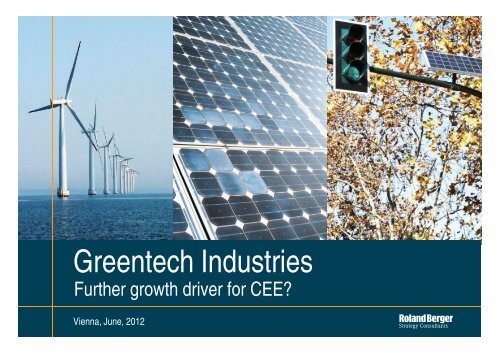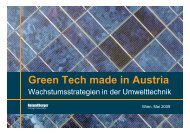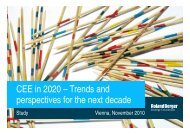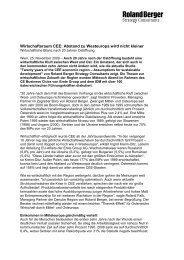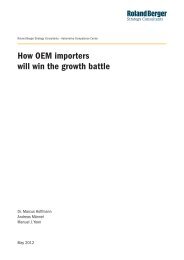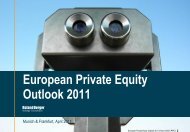Greentech Industries - Roland Berger
Greentech Industries - Roland Berger
Greentech Industries - Roland Berger
You also want an ePaper? Increase the reach of your titles
YUMPU automatically turns print PDFs into web optimized ePapers that Google loves.
<strong>Greentech</strong> <strong>Industries</strong><br />
Further growth driver for CEE?<br />
Vienna, June, 2012<br />
280612_<strong>Greentech</strong>_final.pptx<br />
1
Key hypotheses<br />
1<br />
2<br />
3<br />
4<br />
5<br />
Biggest green industries will further grow above European and global GDP<br />
development – 8.5% on average<br />
Increasing volatility as the main driver for growth beside ecological aspects<br />
The "Green stress" of CEE is on comparable level with Africa and Asia!<br />
CEE as prospering green market – 3.6% expected GDP and green investments<br />
comparable with USA<br />
Four growth patterns will dominate the CEE green industry development<br />
280612_<strong>Greentech</strong>_final.pptx<br />
2
1 GREENTECH MARKETS<br />
The three biggest <strong>Greentech</strong> markets are expected to grow at 8.5%<br />
p.a. – Global GDP growth of approx. 3.5% p.a.<br />
<strong>Greentech</strong> markets – Development 2011-2020 [EUR bn]<br />
1 ENERGY EFFICIENCY 2 SUSTAINABLE WATER<br />
MANAGEMENT<br />
+5%<br />
1,030<br />
652<br />
799<br />
2011<br />
2015<br />
2020<br />
4 SMART ENERGY 5 RESOURCES AND MATERIAL<br />
EFFICIENCY<br />
xx%<br />
Annual growth rate [%]<br />
Ø 8.5%<br />
139<br />
2011<br />
+16%<br />
340<br />
2015<br />
547<br />
2020<br />
Source: BCC Research, <strong>Roland</strong> <strong>Berger</strong> Strategy Consultants<br />
312<br />
2011<br />
+8%<br />
385<br />
2015<br />
+10%<br />
621<br />
2020<br />
2020<br />
3 SUSTAINABLE MOBILITY<br />
6 RECYCLING<br />
111<br />
2011<br />
+4%<br />
128<br />
2015<br />
155<br />
2020<br />
203<br />
333<br />
137 14 21 35<br />
2011<br />
2015<br />
2011<br />
+11%<br />
2015<br />
2020<br />
280612_<strong>Greentech</strong>_final.pptx<br />
3
1 GREENTECH MARKETS<br />
The six <strong>Greentech</strong> markets represent a bundle of several<br />
technologies that aim at achieving sustainability<br />
The six <strong>Greentech</strong> markets<br />
1 ENERGY EFFICIENCY 2 SUSTAINABLE WATER<br />
MANAGEMENT<br />
> Lightning systems<br />
> Housing insulation<br />
> Insulating windows<br />
> Appliances with low<br />
energy consumption<br />
Source: <strong>Roland</strong> <strong>Berger</strong> Strategy Consultants<br />
> Seawater<br />
desalination<br />
> Water infrastructure<br />
upgrade<br />
> Waste water treatment<br />
4 SMART ENERGY 5 RESOURCES AND MATERIAL<br />
EFFICIENCY<br />
> Smart grids<br />
> Solar / wind / hydro<br />
power<br />
> Cogeneration units<br />
> Geothermal units<br />
> Biomass/ biogas<br />
> Bioplastics<br />
> Light construction<br />
> Tribological methods<br />
> Geotextiles<br />
> Biofuels<br />
3 SUSTAINABLE MOBILITY<br />
6 RECYCLING<br />
> Efficiency increase of<br />
conventional ICE's<br />
> Hybrid technologies<br />
> Electric vehicles<br />
> Waste recycling<br />
technologies<br />
> Returnable systems<br />
> Sorting technologies<br />
> Energy recovery<br />
280612_<strong>Greentech</strong>_final.pptx<br />
4
Key hypotheses<br />
1<br />
2<br />
3<br />
4<br />
5<br />
Biggest green industries will further grow above European and global GDP<br />
development – 8.5% on average<br />
Increasing volatility as the main driver for growth beside ecological aspects<br />
The "Green stress" of CEE is on comparable level with Africa and Asia!<br />
CEE as prospering green market – 3.6% expected GDP and green investments<br />
comparable with USA<br />
Four growth patterns will dominate the CEE green industry development<br />
280612_<strong>Greentech</strong>_final.pptx<br />
5
2 INCREASING VOLATILITY<br />
The driver for green industries is volatility of raw material markets<br />
Development of commodity prices, 2007-2011<br />
CRUDE OIL [USD/barrel] NATURAL GAS [USD/1000 m 3 ]<br />
100<br />
[USD] 19 34 29 22 30 [USD] 11 19 18 16 22<br />
50<br />
200<br />
150<br />
100<br />
1/1/07<br />
1/1/07<br />
1/1/08<br />
1/1/08<br />
1/1/09<br />
1/1/09<br />
1/1/10<br />
1/1/10<br />
1/1/11<br />
STEAM COAL [USD/t] 1) COPPER [USD/t]<br />
[USD] 24 61 46 28 30<br />
1/1/11<br />
1) Chinese market xx Volatility [%], yearly average of 30-day-volatility<br />
Source: Reuters, Bloomberg, CR China, <strong>Roland</strong> <strong>Berger</strong> Strategy Consultants<br />
1/1/12<br />
1/1/12<br />
400<br />
200<br />
400<br />
300<br />
200<br />
100<br />
1/1/07<br />
1/1/07<br />
1/1/08<br />
1/1/08<br />
1/1/09<br />
1/1/09<br />
1/1/10<br />
1/1/10<br />
1/1/11<br />
[USD] na na na 27 28<br />
1/1/11<br />
1/1/12<br />
1/1/12<br />
280612_<strong>Greentech</strong>_final.pptx<br />
6
2 INCREASING VOLATILITY<br />
The CO 2 discussion remains important – but the drive is decreasing<br />
Development of average temperature vs. concentration of CO 2<br />
Avg. temperature vs. CO 2 concentration<br />
[ppm] [°C] Kyoto protocol<br />
> Stabilization of greenhouse gas<br />
concentrations in the atmosphere<br />
0.4<br />
> Worldwide country coverage<br />
450 0.6<br />
400<br />
350<br />
300<br />
1920<br />
1930<br />
1940<br />
CO 2 concentration [ppm]<br />
1950<br />
1960<br />
1970<br />
1980<br />
1990<br />
Temperature above 1931-1960 mean [°C]<br />
Source: Carbon Dioxide Information Analysis Center, <strong>Roland</strong> <strong>Berger</strong> Strategy Consultants<br />
2000<br />
2010<br />
0.2<br />
0.0<br />
-0.2<br />
-0.4<br />
-0.6<br />
-0.8<br />
1997<br />
2005<br />
2008<br />
Emission Trading<br />
> Market-based approach to<br />
reduce pollution by pro-viding<br />
trading mechanisms like CO 2<br />
certificates<br />
EU energy directive<br />
'20-20-20'<br />
> Series of demanding climate and<br />
energy targets until 2020<br />
280612_<strong>Greentech</strong>_final.pptx<br />
7
2 INCREASING VOLATILITY<br />
And let´s face it - is open dumping of up to 80% the right way to<br />
treat resources?<br />
Comparison of waste disposal by world region [%]<br />
Western Europe<br />
North America<br />
17<br />
20<br />
39<br />
5 5<br />
6<br />
Asia<br />
29<br />
7<br />
24<br />
84<br />
4<br />
15<br />
3<br />
65<br />
25<br />
South America<br />
9 4<br />
12 1<br />
74<br />
Africa<br />
Landfill Incineration Composting Recycling Open dumping<br />
Source: <strong>Roland</strong> <strong>Berger</strong> Strategy Consultants<br />
12<br />
78<br />
CEE<br />
Australia<br />
28<br />
18<br />
54<br />
54<br />
280612_<strong>Greentech</strong>_final.pptx<br />
8
Key hypotheses<br />
1<br />
2<br />
3<br />
4<br />
5<br />
Biggest green industries will further grow above European and global GDP<br />
development – 8.5% on average<br />
Increasing volatility as the main driver for growth beside ecological aspects<br />
The "Green stress" of CEE is on comparable level with Africa and Asia!<br />
CEE as prospering green market – 3.6% expected GDP and green investments<br />
comparable with USA<br />
Four growth patterns will dominate the CEE green industry development<br />
280612_<strong>Greentech</strong>_final.pptx<br />
9
3 "GREEN STRESS"<br />
To rationalize the importance of Green industries in a global<br />
comparison <strong>Roland</strong> <strong>Berger</strong> developed the "Green Stress Indicator"<br />
Comparison of the "Green Stress Indicator"<br />
GREENTECH MARKETS<br />
1 Energy efficiency<br />
2 Sustainable water management<br />
3 Sustainable mobility<br />
4 Smart energy<br />
5 Resources and material efficiency<br />
6 Recycling<br />
Source: <strong>Roland</strong> <strong>Berger</strong> Strategy Consultants<br />
INDICATORS PER MARKET<br />
Energy consumption per GDP unit<br />
Share of population without access to improved water<br />
> Growth rate of cars<br />
> Growth of cars per 1,000 capita<br />
> Current share of non-renewables<br />
> Planned increase of renewables per capita<br />
Steel consumption per GDP unit<br />
Share of waste put on landfill or open dumps<br />
280612_<strong>Greentech</strong>_final.pptx<br />
GREEN STRESS<br />
10
3 "GREEN STRESS"<br />
CEE, Asia and Africa show a comparable level of "Green Stress"<br />
"Green Stress" 1)<br />
HIGH<br />
LOW<br />
Problem Problem intensity intensity<br />
154<br />
28<br />
11 15<br />
6<br />
22<br />
72<br />
North<br />
America<br />
205<br />
38<br />
21<br />
34<br />
16<br />
96<br />
South<br />
America<br />
16<br />
32<br />
15<br />
8<br />
43<br />
Western<br />
Europe<br />
1) Index: 0=Low, 600=High intensity of environmental stress<br />
Source: <strong>Roland</strong> <strong>Berger</strong> Strategy Consultants<br />
114<br />
394<br />
80<br />
7<br />
69<br />
87<br />
58<br />
93<br />
CEE<br />
461<br />
100<br />
100<br />
29<br />
100<br />
32<br />
100<br />
Africa<br />
169<br />
23<br />
49<br />
13 24<br />
60<br />
Australia<br />
405<br />
56<br />
35<br />
69<br />
69<br />
100<br />
76<br />
Asia<br />
Energy efficiency<br />
Sustainable water management<br />
Sustainable mobility<br />
Smart energy<br />
Resources and material efficiency<br />
Recycling<br />
280612_<strong>Greentech</strong>_final.pptx<br />
11
3 SMART ENERGY<br />
Smart energy options offer an enormous potential for CEE<br />
Problem indicator and geographical comparison<br />
INDICATOR AND RATIONALE<br />
100<br />
87<br />
> Rationale: Problematic mismatch between actual<br />
need for renewable energy and planned increase<br />
> Indicator: Combination of<br />
– Current share of non-renewable energy 2008<br />
– Planned increase of renewable energy per<br />
capita from 2008 until 2020<br />
GEOGRAPHICAL COMPARISON (Index 100 = average)<br />
Source: IEA/OECD: World Energy Outlook 2010, <strong>Roland</strong> <strong>Berger</strong> Strategy Consultants<br />
69<br />
24<br />
Africa Central & Asia Australia North Western South<br />
Eastern<br />
America Europe America<br />
Europe1) 1) CEE = ALB, BLG, HRV, CZE, HUN, POL, ROU, SLK, SVN, EST, LTU, LVA<br />
15<br />
8<br />
0<br />
COMMENTS<br />
> Africa has 95% of nonrenewable<br />
energy – No<br />
adequate plans for future<br />
development made yet<br />
> Energy infrastructure in Central<br />
& Eastern Europe is still<br />
characterized by high share of<br />
non-renewable energy like<br />
coal, oil, gas and nuclear power<br />
– Only EU members have<br />
ambitious plans<br />
> Asia's enormous growth bases<br />
on coal and nuclear power –<br />
However, first renewable<br />
industries have developed, e.g.<br />
wind power in China<br />
280612_<strong>Greentech</strong>_final.pptx<br />
12
3 ENERGY EFFICIENCY<br />
Industrially developed regions and regions with a sizeable heavy<br />
industry show the highest potential in energy efficiency<br />
Problem indicator and geographical comparison<br />
INDICATOR AND RATIONALE<br />
100<br />
80<br />
> Rationale: Low energy efficiency leads to high<br />
energy consumption per unit of GDP<br />
> Indicator: Energy consumption per million GDP<br />
2009 [TWh/EURm]<br />
GEOGRAPHICAL COMPARISON (Index 100=9,257 TWh/EUR m)<br />
56<br />
38<br />
Africa Central & Asia South North Australia Western<br />
Eastern<br />
America America<br />
Europe<br />
Europe1) 1) CEE = ALB, BLG, BIH, BLR, CZE, EST, HRV, HUN, LTU, LVA, MDA, MKD, MNE, POL, ROU, RUS, SRB, SLK, SVN, TUR, UKR<br />
Source: IMF Database, BP Statistical Review, <strong>Roland</strong> <strong>Berger</strong> Strategy Consultants<br />
28<br />
23<br />
16<br />
COMMENTS<br />
> Considering the level of energy<br />
efficiency, the world regions can<br />
by divided in regions with high<br />
energy efficiency (industrially<br />
developed areas like North/<br />
South America, Western Europe<br />
and Australia) and regions with<br />
low energy efficiency, e.g.<br />
Africa, CEE and Asia<br />
> The CEE region has a<br />
surprisingly low level of<br />
efficiency which may be<br />
attributed to the huge existing<br />
heavy industry sector<br />
280612_<strong>Greentech</strong>_final.pptx<br />
13
3 SUSTAINABLE MOBILITY<br />
CEE and Asia show the highest pressure caused by growth of the<br />
car pool – However, only limited growth push until 2020<br />
Problem indicator and geographical comparison<br />
INDICATOR AND RATIONALE<br />
GEOGRAPHICAL COMPARISON<br />
69<br />
Central &<br />
Eastern<br />
Europe<br />
69<br />
Asia<br />
Source: JD Power; <strong>Roland</strong> <strong>Berger</strong> Strategy Consultants<br />
> Rationale: The faster the number of vehicles<br />
grows, the higher the pressure to develop<br />
sustainable mobility<br />
> Indicator: Combination of growth rates 2008-2020<br />
– Growth rate of cars (Index 50=7.5% p.a.)<br />
– Growth of cars per 1000 capita (Index 50=180)<br />
49<br />
Australia<br />
32<br />
Western<br />
Europe<br />
29<br />
Africa 1)<br />
22<br />
North<br />
America<br />
21<br />
South<br />
America<br />
1) CEE = ALB, BLG, BIH, BLR, CZE, EST, HRV, HUN, LTU, LVA, MDA, MKD, MNE, POL, ROU, RUS, SRB, SLK, SVN, TUR, UKR<br />
COMMENTS<br />
> Two regions dominate the<br />
problem intensity index: Central<br />
& Eastern Europe and Asia<br />
> First e-mobility pilots are currently<br />
in development, however<br />
significant share of electric<br />
vehicles only after 2020<br />
expected<br />
> China invests huge amounts in<br />
electro-mobility – Major global<br />
resources of rare earth that are<br />
needed for batteries are located<br />
in China<br />
280612_<strong>Greentech</strong>_final.pptx<br />
14
3 RESOURCES AND MATERIAL EFFICIENCY<br />
Asia and CEE show a comparably high resource intensity – Heavy<br />
industry still makes up a high share of the regional GDP<br />
Problem indicator and geographical comparison<br />
INDICATOR AND RATIONALE<br />
> Rationale: Inefficient use of materials leads to high<br />
steel consumption per unit of GDP<br />
> Indicator: Kilograms of steel consumed per<br />
thousand Euro GDP 2010 [kg/'000 EUR]<br />
GEOGRAPHICAL COMPARISON (Index 100 = 76 kg/'000 EUR)<br />
100<br />
Asia<br />
58<br />
Central &<br />
Eastern<br />
Europe<br />
34<br />
South<br />
America<br />
32<br />
Africa<br />
15<br />
Western<br />
Europe<br />
13<br />
Australia 1)<br />
1) CEE = BLG, CYP, CZE, EST, HUN, LTU, LVA, MLT, POL, ROU, SLK, SVN; WE = EU 15<br />
Source: World Steel Association; Economits Intelligence Unit; <strong>Roland</strong> <strong>Berger</strong> Strategy Consultants<br />
11<br />
North<br />
America<br />
COMMENTS<br />
> Scarcity of resources is<br />
commonly agreed to be one of<br />
the future megatrends<br />
> The regions of Asia and<br />
Central & Eastern Europe<br />
show a comparably high<br />
resource intensity – Heavy<br />
industry still makes up a high<br />
share of the regional GDP<br />
280612_<strong>Greentech</strong>_final.pptx<br />
15
3 RECYCLING<br />
Regions with low GDP per capita like South America, Africa and<br />
Asia still with high share of open dumps – CEE as exception<br />
Problem indicator and geographical comparison<br />
INDICATOR AND RATIONALE<br />
Source: <strong>Roland</strong> <strong>Berger</strong> Strategy Consultants<br />
> Rationale: The higher the share of waste put on<br />
landfills or open dumps, the higher the need for<br />
investments in waste collection/treatment systems<br />
> Indicator: Share of waste put on landfills or open<br />
dumps [%]<br />
GEOGRAPHICAL COMPARISON (Index 100 = 90%)<br />
1.7 4.2 5.5 3.0 26.8 30.6 27.8<br />
100<br />
13<br />
87<br />
Africa<br />
Landfills<br />
96<br />
13<br />
82<br />
South<br />
America<br />
Open dumps<br />
93<br />
93<br />
Central &<br />
Eastern<br />
Europe<br />
xx<br />
76<br />
17<br />
60<br />
Asia<br />
GDP/capita ['000 EUR]<br />
72 60<br />
72 60<br />
North<br />
America<br />
1) CEE = BIH, MKD, BLG, ROU, HRV, TUR, LTU, LVA, SLK, CZE, POL, EST, HUN<br />
Australia<br />
43<br />
43<br />
Western<br />
Europe<br />
COMMENTS<br />
> World regions with low GPD<br />
per capita like South America,<br />
Africa and Asia still with high<br />
share of open dumps – CEE<br />
as the only exception<br />
> Established waste collection<br />
systems in CEE assumed as<br />
no relevant share of open<br />
dumping reported – However,<br />
93% of the waste is not treated<br />
adequately and put on landfills<br />
280612_<strong>Greentech</strong>_final.pptx<br />
16
3 SUSTAINABLE WATER MANAGEMENT<br />
Africa and Asia still lacking basic water supply – Advanced technologies<br />
like waste water treatment are topics of developed countries<br />
Problem indicator and geographical comparison<br />
INDICATOR AND RATIONALE<br />
> Rationale: Sustainable water management<br />
ensures access to improved drinking water<br />
> Indicator: Share of population without access to<br />
improved drinking water 2008 [%]<br />
GEOGRAPHICAL COMPARISON (Index 100 = 35%)<br />
100<br />
Africa<br />
35<br />
Asia<br />
16<br />
South<br />
America<br />
7<br />
Central &<br />
Eastern<br />
Europe<br />
6<br />
North<br />
America 1)<br />
0<br />
Western<br />
Europe<br />
0<br />
Australia<br />
1) CEE = ALB, BLG, BIH, BLR, CZE, EST, HRV, HUN, LTU, LVA, MDA, MKD, MNE, POL, ROU, RUS, SRB, SLK, SVN, TUR, UKR<br />
Source: WHO/UNICEF: Joint Monitoring Programme (JMP); <strong>Roland</strong> <strong>Berger</strong> Strategy Consultants<br />
COMMENTS<br />
> Africa and Asia are lacking<br />
basic water supply – In Africa,<br />
only 35% of the population has<br />
access to improved drinking<br />
water<br />
> Developed regions like North<br />
and South America, Europe and<br />
Australia have are able to offer<br />
comprehensive water supply<br />
– Advanced technologies to<br />
ensure sustainable water use<br />
are the focus topics, e.g.<br />
waste water treatment<br />
280612_<strong>Greentech</strong>_final.pptx<br />
17
Key hypotheses<br />
1<br />
2<br />
3<br />
4<br />
5<br />
Biggest green industries will further grow above European and global GDP<br />
development – 8.5% on average<br />
Increasing volatility as the main driver for growth beside ecological aspects<br />
The "Green stress" of CEE is on comparable level with Africa and Asia!<br />
CEE as prospering green market – 3.6% expected GDP and green investments<br />
comparable with USA<br />
Four growth patterns will dominate the CEE green industry development<br />
280612_<strong>Greentech</strong>_final.pptx<br />
18
4 CEE AS PROSPERING GREEN MARKET<br />
CEE as a promising market – 3.6% of GDP development per anno<br />
combined with an attractive <strong>Greentech</strong> investment per capita<br />
Investments in <strong>Greentech</strong> by world region<br />
Western Europe<br />
27.8<br />
96<br />
North America<br />
26.8<br />
63<br />
1.4%<br />
5.5 3.6%<br />
62<br />
Asia<br />
2.2%<br />
CEE 3)<br />
South America Africa<br />
Australia<br />
30.6<br />
32<br />
4.2 3.9%<br />
1.7 3.3%<br />
22<br />
2.9%<br />
21<br />
GDP per capita 2010 1) ['000 EUR] GDP growth until 2020 1) [% p.a.] Investment in <strong>Greentech</strong> per capita [EUR]<br />
1) Based on EIU database including 89 countries 2) Investments in the segments 'Energy efficiency', 'Sustainable water management', 'Smart energy' and ' Resources/material efficiency'<br />
3) CEE – AL, BA, BG, HR, CZ, EE, HU, LV, LT, MK, PL, RO, RU, RS, SK, SI, TR, UA<br />
Source: Economist Intelligence Unit; <strong>Roland</strong> <strong>Berger</strong> Strategy Consultants<br />
3.0<br />
4.6%<br />
15<br />
280612_<strong>Greentech</strong>_final.pptx<br />
19
4 CEE AS PROSPERING GREEN MARKET<br />
Green industries in CEE is developing to a key topic – Growth<br />
machines are Smart Energy and Energy Efficiency<br />
<strong>Greentech</strong> lifecycle in CEE<br />
ENERGY<br />
EFFICIENCY<br />
SUSTAINABLE<br />
WATER MGMT<br />
SUSTAINABLE<br />
MOBILITY<br />
MARKET<br />
MATURITY BECOMING<br />
A TOPIC<br />
MARKETING<br />
SMART<br />
ENERGY<br />
RESSOURCE<br />
EFFICIENCY<br />
RECYCLING<br />
Bubble size indicates market volume<br />
Source: <strong>Roland</strong> <strong>Berger</strong> – CEE 2020 study<br />
RAMP UP OF<br />
SIZEABLE<br />
PROJECTS<br />
MATURE<br />
INDUSTRY<br />
COMMENTS<br />
> Smart Energy as frontrunner<br />
– Focus on renewables (wind,<br />
water and photovoltaic)<br />
– Smart grid not on start term<br />
> Energy Efficiency and<br />
sustainable meter management<br />
already in sizeable manner<br />
> Ressource efficiency on its<br />
start to becoming a key topic<br />
> "Recycling" – ramping up<br />
incineration (e.g. Poland) and<br />
first signs of improving recycling<br />
systems<br />
280612_<strong>Greentech</strong>_final.pptx<br />
20
4 ENERGY EFFICIENCY<br />
Countries in Central and Eastern Europe show significant potential<br />
in energy intensity<br />
Energy intensity (kilograms oil equivalent per 1,000 EUR GDP)<br />
2,000<br />
1,500<br />
1,000<br />
500<br />
0<br />
BGR<br />
ROU<br />
CZE<br />
Source: Eurostat; <strong>Roland</strong> <strong>Berger</strong> Strategy Consultants<br />
SVK<br />
LVA<br />
POL<br />
HUN<br />
EST<br />
EU25<br />
~8 x<br />
EU27<br />
DEU<br />
AUT<br />
280612_<strong>Greentech</strong>_final.pptx<br />
21
4 SUSTAINABLE WATER MANAGEMENT<br />
In sustainable water and air management investments of approx.<br />
EUR 115 bn are necessary to reach the EU acquis<br />
Investment to reach EU-acquis [EUR bn]<br />
∑ 115.00 34.75 21.09 16.90 15.60 14.70 12.55 4.75 1.84<br />
Supply<br />
17.50<br />
33.10<br />
48.20<br />
16.20<br />
Total<br />
Waste water<br />
4.40<br />
13.70<br />
13.90<br />
2.75<br />
Poland<br />
Air<br />
Source: World Bank, <strong>Roland</strong> <strong>Berger</strong> Strategy Consultants<br />
3.80<br />
6.30<br />
9.10<br />
1.89<br />
Romania<br />
Total avarage<br />
1.10<br />
5.10 6.40<br />
2.20<br />
2.70 2.20<br />
6.90<br />
Bulgaria<br />
5.90<br />
Czech Rep.<br />
5.25<br />
8.45<br />
0.65<br />
Baltic<br />
0.35<br />
3.50<br />
3.10<br />
3.25<br />
Hungary<br />
2.70<br />
1.00<br />
1.90<br />
0.95 0.90<br />
Slovakia<br />
0.69<br />
1.15<br />
Slovenia<br />
280612_<strong>Greentech</strong>_final.pptx<br />
22
4 SUSTAINABLE MOBILITY<br />
All e-mobility stakeholders need to start getting ready now to be<br />
prepared for the upswing in "post 2015" markets<br />
Expected EV/PHEV market development in CEE ['000 units]<br />
Share of total<br />
cars sold [%] 1) ~2% ~13% ~23%<br />
800<br />
600<br />
400<br />
200<br />
0<br />
2010 2012 2014 2016 2018 2020 2022 2024 2026 2028 2030<br />
PHASE I:<br />
Get ready<br />
> Gather know-how in pilot projects<br />
> Define future strategies and<br />
business models<br />
> Start mass production<br />
> Build awareness<br />
> Attract first EV users<br />
PHASE II: Develop a competitive<br />
advantage<br />
> Develop systems and processes,<br />
standardize technology<br />
> Start building mass customer<br />
base (B2B focus)<br />
> Differentiate, develop USP<br />
> Legislate and develop safety<br />
standards<br />
PHASE III:<br />
Gain market share<br />
> Turn into fully fledged business<br />
> Gain mass customer base (B2C<br />
focus)<br />
> Gain market share<br />
> Develop new generation of xEVs<br />
> Customize products<br />
PHASE IV: Run a profitable<br />
business<br />
> Turn into profit generator<br />
> Continuously optimize<br />
Know-how and publicity focus Profit focus<br />
1) Only private cars and LCV (light commercial vehicles) considered<br />
Source: <strong>Roland</strong> <strong>Berger</strong><br />
280612_<strong>Greentech</strong>_final.pptx<br />
23
4 SUSTAINABLE MOBILITY<br />
In the more developed CEE countries e-mobility starts to develop to<br />
a sizeable topic – At least in marketing terms<br />
Prague, Czech Republic<br />
> CEZ<br />
> OEM partner: Peugeot<br />
> 65 EVs<br />
> 150 charging stations<br />
> Investment: n/a<br />
Salzburg, Austria<br />
> Die Salzburg Netz GmbH<br />
> OEM partner: TH!NK<br />
> 1,000 EVs planned<br />
> 50 charging stations<br />
> EUR 1.9 m government funds<br />
Voralberg, Austria<br />
> Illwerke VKW<br />
> OEM partner: TH!NK, Fiat,<br />
Mazda, Mitsubishi, Renault<br />
> 250 EVs planned<br />
> 32 charging stations<br />
> EUR 4.7 m government funds<br />
Source: <strong>Roland</strong> <strong>Berger</strong> Strategy Consultants<br />
Warszawa, Gdańsk, Katowice,<br />
Kraków, Mielec, Poland<br />
> Green Stream Cluster<br />
> OEM partner: none<br />
> 20 EVs<br />
> 330 charging stations<br />
> EUR 4.8 m government funds<br />
Warszawa, Poland<br />
> RWE<br />
> OEM partner: Fiat<br />
> 6 EVs<br />
> 130 charging stations<br />
> Investment: n/a<br />
Wörthersee, Villach, St. Veit,<br />
Austria<br />
> RWE, Kelag<br />
> OEM partner: none<br />
> Number of EVs: n/a<br />
> 106 charging stations<br />
> Investment: n/a<br />
COMMENTS<br />
> In 2020, approx. 20% of<br />
the cars will have at least<br />
hybrid engine systems in<br />
Western Europe<br />
> E-mobility will give the<br />
possibility of energy<br />
storage<br />
> Need for the integrated<br />
part of grid planning<br />
especially in the cities<br />
> On short term, e-mobility is<br />
not a relevant utility market<br />
but for grid structure<br />
planning it is essential<br />
280612_<strong>Greentech</strong>_final.pptx<br />
24
4 SMART ENERGY<br />
Substantial gaps in renewable energy targets and attractive feed in<br />
tariffs drive the market<br />
RENEWABLE TARGETS IN CE FEED IN TARIFFS<br />
34.0%<br />
23.3%<br />
RES as share of energy supply [%]:<br />
Source: <strong>Roland</strong> <strong>Berger</strong><br />
13.0%<br />
6.1%<br />
25.0%<br />
16.0%<br />
15.0%<br />
7.2%<br />
14.0%<br />
6.8%<br />
13.0%<br />
4.3%<br />
2005 2020<br />
24.0%<br />
17.8%<br />
16.0%<br />
9.4%<br />
Austria<br />
Bulgaria<br />
Czech Republic<br />
Hungary<br />
Poland<br />
Romania<br />
Slovenia<br />
Turkey<br />
CEE average<br />
France<br />
Germany<br />
Spain<br />
WE average<br />
BIOMASS<br />
(up to 500 kW)<br />
14.94<br />
9.29<br />
9.94<br />
9.14<br />
n/a<br />
n/a<br />
16.01<br />
n/a<br />
11.86<br />
4.90<br />
9.18<br />
16.42<br />
10.17<br />
SOLAR/PV HYDRO<br />
(small scale) –<br />
less than 10 MW<br />
45.98<br />
38.60<br />
49.25<br />
11.42<br />
n/a<br />
n/a<br />
41.55<br />
28.00<br />
35.80<br />
30.00<br />
31.94<br />
45.51<br />
35.82<br />
1) 150-500 kW 5) Over 30 kW<br />
2)
4 SMART ENERGY<br />
Growth markets seem to develop in CEE – But still differences in the<br />
countries legislation<br />
Growth matrix COMMENTS<br />
Revenue<br />
potential<br />
2011-2014<br />
[EUR m]<br />
DEU/BM<br />
HUN/WK<br />
DEU/WO<br />
HUN/BM<br />
POL/WK<br />
SVK/WK<br />
SVK/BG<br />
DEU/BG<br />
AUT/BG<br />
CZE/WO<br />
ITA/WO<br />
BGR/WK<br />
DEU/PV<br />
BGR/BM<br />
ITA/PV<br />
POL/WO<br />
TUR/WK<br />
ITA/BM<br />
POL/BM<br />
ROU/WO<br />
POL/BG<br />
CZE/BM<br />
AUT/WO<br />
ITA/BG<br />
BGR/WO<br />
SWE/WO<br />
CZE/BG SVK/BM HUN/WO<br />
ROU/WK<br />
TUR/BM<br />
AUT/BM<br />
BIH/WK<br />
ROU/BM<br />
TUR/PV<br />
SVK/WO<br />
HUN/BG<br />
POL/PV<br />
HUN/PV<br />
ROU/PV<br />
BGR/PV<br />
ROU/BG<br />
BGR/BG<br />
Relative growth<br />
> Country Energy programs<br />
commit to substantial<br />
renewable development<br />
TUR/WO > Beside growth<br />
AUT/PV<br />
perspectives the legal<br />
framework varies highly<br />
> Sizeable growth markets<br />
in CEE renewables<br />
– Romania<br />
– Bulgaria<br />
– Turkey<br />
280612_<strong>Greentech</strong>_final.pptx<br />
26
4 GREEN SALES<br />
Nine CEE countries range under the global "Top 25" in terms of<br />
greentech sales weighted by GDP<br />
<strong>Greentech</strong> sales weighted by GDP [EUR, %]<br />
Ranking<br />
2011 2010 Top 5 fastest climbers, 2010-2011<br />
1<br />
2<br />
3<br />
4<br />
5<br />
6<br />
7<br />
8<br />
9<br />
10<br />
11<br />
12<br />
13<br />
14<br />
15<br />
16<br />
17<br />
18<br />
19<br />
20<br />
21<br />
22<br />
23<br />
24<br />
25<br />
(1)<br />
(2)<br />
(3)<br />
(4)<br />
(8)<br />
(6)<br />
(7)<br />
(–)<br />
(11)<br />
(15)<br />
(5)<br />
(10)<br />
(13)<br />
(12)<br />
(17)<br />
(16)<br />
(19)<br />
(–)<br />
(14)<br />
(9)<br />
(18)<br />
(23)<br />
(20)<br />
(21)<br />
(26)<br />
Denmark<br />
China<br />
Germany<br />
Brazil<br />
South Korea<br />
Czech Republic<br />
Spain<br />
Slovenia<br />
Latvia<br />
Taiwan<br />
Lithuania<br />
Belgium<br />
Finland<br />
Japan<br />
United States<br />
India<br />
Hungary<br />
Norway<br />
Poland<br />
Austria<br />
Netherlands<br />
Sweden<br />
France<br />
Slovakia<br />
Bulgaria<br />
Sales increased in 2011 Sales declined in 2011<br />
Source: <strong>Roland</strong> <strong>Berger</strong>; WWF<br />
0%<br />
1% 2% 3%<br />
China +18% p.a.<br />
South Korea +15% p.a.<br />
Latvia<br />
Taiwan<br />
United States<br />
0%<br />
Value in<br />
2010<br />
Value in<br />
2011<br />
+33% p.a.<br />
+30% p.a.<br />
+16% p.a.<br />
2%<br />
280612_<strong>Greentech</strong>_final.pptx<br />
27
Key hypotheses<br />
1<br />
2<br />
3<br />
4<br />
5<br />
Biggest green industries will further grow above European and global GDP<br />
development – 8.5% on average<br />
Increasing volatility as the main driver for growth beside ecological aspects<br />
The "Green stress" of CEE is on comparable level with Africa and Asia!<br />
CEE as prospering green market – 3.6% expected GDP and green investments<br />
comparable with USA<br />
Four growth patterns will dominate the CEE green industry development<br />
280612_<strong>Greentech</strong>_final.pptx<br />
28
5<br />
GROWTH PATTERNS<br />
Four <strong>Greentech</strong> growth patterns will dominate CEE markets<br />
Green industry growth patterns<br />
1 GROWTH<br />
> Reach renewable targets<br />
> Invest in energy efficiency<br />
> Upgrade recycling systems<br />
> Invest in modern mobility<br />
solutions<br />
4<br />
NEARLY MATURE<br />
> High investment potential<br />
> No clear allocation strategy<br />
now<br />
> Green mobility<br />
> Smart energy solutions<br />
2 EARLY STAGE<br />
> Built up basic infrastructure<br />
> Reach environmental<br />
standards<br />
3<br />
> Focus on water & waste<br />
management and basic utility<br />
infrastructures<br />
> Highest growth expectations<br />
CATCH UP<br />
> Between 1 and 2<br />
> First big renewable projects<br />
> Still on a volatile base(legal<br />
framework, subsidies)<br />
280612_<strong>Greentech</strong>_final.pptx<br />
29
5<br />
But on the supply side the manufacturing footprint is getting weaker<br />
– strategic vision and capital needed<br />
Growth in selected European cleantech segment 2010-2011 [EUR bn]<br />
European manufacturing value [EUR bn]<br />
SOLAR PV<br />
WIND<br />
BIOFUELS<br />
ENERGY<br />
EFFICIENCY<br />
GROWTH PATTERNS<br />
Source: <strong>Roland</strong> <strong>Berger</strong> analysis<br />
9.2 7.8<br />
18.1 18.1<br />
11.9<br />
8.8<br />
2010<br />
9.2<br />
9.2<br />
2011<br />
European growth [%] Global growth [%]<br />
-15 11<br />
-22 5<br />
0<br />
5<br />
4<br />
22<br />
COMMENTS<br />
> A clear strategic<br />
vision from the EU is<br />
needed to set the<br />
basis for long term<br />
planning<br />
> More capital for<br />
greentech companies<br />
and start ups<br />
280612_<strong>Greentech</strong>_final.pptx<br />
30
Alexander Kainer<br />
+43 1 536 02 139<br />
Alexander_Kainer@at.rolandberger.com<br />
Thank you!<br />
It's character<br />
that creates<br />
impact!<br />
280612_<strong>Greentech</strong>_final.pptx<br />
31


